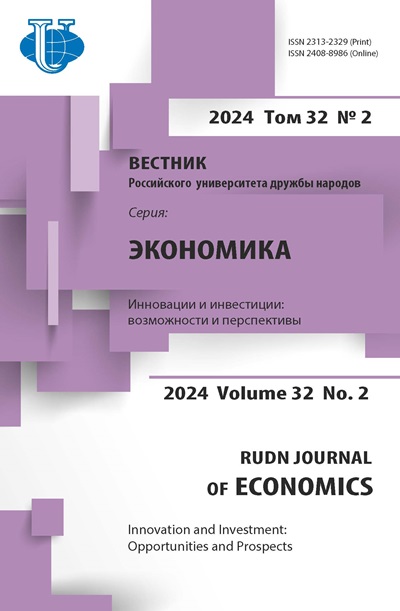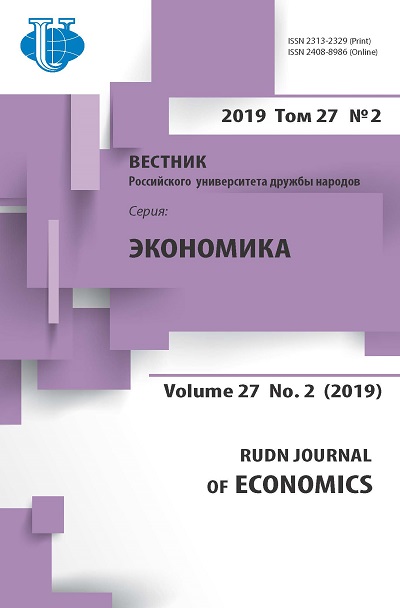Роль интеграции на рынке труда, владения языком и межэтнических контактов в формировании удовлетворенности жизнью среди иммигрантов в Нидерландах
- Авторы: Плетнева Ю.Э.1
-
Учреждения:
- Институт социально-политических исследований РАН
- Выпуск: Том 27, № 2 (2019)
- Страницы: 326-337
- Раздел: МИРОВОЙ РЫНОК ТРУДА И МЕЖДУНАРОДНАЯ МИГРАЦИЯ
- URL: https://journals.rudn.ru/economics/article/view/22183
- DOI: https://doi.org/10.22363/2313-2329-2019-27-2-326-337
Цитировать
Полный текст
Аннотация
Исследования показывают относительно низкую удовлетворенность жизнью среди иммигрантов и этнических меньшинств. В то же время доказано, что субъективное благополучие играет важную роль в процессе социальной интеграции иммигрантов. Настоящее исследование вносит вклад в существующую литературу, исследуя медиативную роль интеграции на рынке труда и межэтнических контактов в связи между знанием языка и удовлетворенностью жизнью среди первого и второго поколений турецких и марокканских иммигрантов в Нидерландах. На основе данных голландского лонгитюдного исследования жизненного курса (NELLS) был проведен анализ методом моделирования структурными уравнениями. Результаты показали, что хотя владение языком не оказывает прямого эффекта на повышение удовлетворенности жизнью среди иммигрантов, оно действительно имеет положительное воздействие через повышение трудовой интеграции и увеличение контактов с представителями этнического большинства.
Об авторах
Юлия Эдуардовна Плетнева
Институт социально-политических исследований РАН
Email: julpletneva@yandex.ru
младший научный сотрудник Центра социальной демографии Российская Федерация, 119333, Москва, ул. Фотиевой, д. 6, корп. 1
Список литературы
- Algan, Y., Dustmann, C., Glitz, A., & Manning, A. (2010). The Economic Situation of First and Second-Generation Immigrants in France, Germany and the United Kingdom. The Economic Journal, 120(542), F4-F30.
- Arrindell, W.A., Heesink, J., & Feij, J.A. (1999). The satisfaction with life scale (SWLS): Appraisal with 1700 healthy young adults in The Netherlands. Personality and individual differences, 26(5), 815-826.
- Barlow, F.K., Paolini, S., Pedersen, A., Hornsey, M.J., Radke, H.R., Harwood, J., ... & Sibley, C.G. (2012). The contact caveat negative contact predicts increased prejudice more than positive contact predicts reduced prejudice. Personality and Social Psychology Bulletin, 38(12), 1629-1643.
- Bevelander, P. (2000). Immigrant employment integration and structural change in Sweden, 1970-1995 (vol. 15). Lund University.
- Bjørnskov, C., Dreher, A., & Fischer, J.A. (2008). Cross-country determinants of life satisfaction: Exploring different determinants across groups in society. Social Choice and Welfare, 30(1), 119-173.
- Bleakley, H., & Chin, A. (2004). Language skills and earnings: Evidence from childhood immigrants. Review of Economics and Statistics, 86(2), 481-496.
- Böhnke, P. (2008). Does society matter? Life satisfaction in the enlarged Europe. Social Indicators Research, 87(2), 189-210.
- Bonini, A.N. (2008). Cross-national variation in individual life satisfaction: Effects of national wealth, human development, and environmental conditions. Social Indicators Research, 87(2), 223-236.
- Borjas, G.J. (1987). Self-selection and the earnings of immigrants. American Economic Review, 77(4), 531-553.
- Chiswick, B.R., & Miller, P.W. (2001). A model of destination-language acquisition: Application to male immigrants in Canada. Demography, 38(3), 391-409.
- Christopher, K.A., & Kulig, J.C. (2000). Determinants of psychological well-being in Irish immigrants. Western Journal of Nursing Research, 22(2), 123-143.
- Crul, M., & Vermeulen, H. (2003). The second generation in Europe. International migration review, 37(4), 965-986.
- Delander, L., Hammarstedt, M., Månsson, J., & Nyberg, E. (2005). Integration of immigrants: the role of language proficiency and experience. Evaluation Review, 29(1), 24-41.
- Diener, E.D., Emmons, R.A., Larsen, R.J., & Griffin, S. (1985). The satisfaction with life scale. Journal of personality assessment, 49(1), 71-75.
- Diwan, S. (2008). Limited English proficiency, social network characteristics, and depressive symptoms among older immigrants. The Journals of Gerontology Series B: Psychological Sciences and Social Sciences, 63(3), S184-S191.
- Eckstein, Z., & Weiss, Y. (2002). The integration of immigrants from the former Soviet Union in the Israeli labor market. The Israeli Economy, 1985-1998: From Government Intervention to Market Economics, 349-377.
- Ersanilli, E., & Koopmans, R. (2010). Rewarding integration? Citizenship regulations and the socio-cultural integration of immigrants in the Netherlands, France and Germany. Journal of Ethnic and Migration Studies, 36(5), 773-791.
- Esser, H. (2006). Migration, language and integration. WZB
- Fugl-Meyer, A.R., Melin, R., & Fugl-Meyer, K.S. (2002). Life satisfaction in 18-to 64-yearold Swedes: in relation to gender, age, partner and immigrant status. Journal of Rehabilitation Medicine, 34(5), 239-246.
- Hamberger, J., & Hewstone, M. (1997). Inter-ethnic contact as a predictor of blatant and subtle prejudice: Tests of a model in four West European nations. British Journal of Social Psychology, 36(2), 173-190.
- Helliwell, J.F. (2003). How's life? Combining individual and national variables to explain subjective well-being. Economic Modelling, 20(2), 331-360.
- Hiebert, D. (2009). The economic integration of immigrants in metropolitan Vancouver. IRPP.
- Hong, S.M., Bianca, M.A., Bianca, M.R., & Bollington, J. (1993). Self-esteem: the effects of life-satisfaction, sex, and age. Psychological Reports, 72(1), 95-101.
- Jasinskaja-Lahti, I., Liebkind, K., Jaakkola, M., & Reuter, A. (2006). Perceived discrimination, social support networks, and psychological well-being among three immigrant groups. Journal of Cross-Cultural Psychology, 37(3), 293-311.
- Jasso, G., & Rosenzweig, M.R. (1990). English language proficiency and the locational choices of immigrants. In The new chosen people: immigrants in the United States (pp. 308-337). New York, Russell Sage Foundation.
- Kalmijn, M., & Van Tubergen, F. (2006). Ethnic intermarriage in the Netherlands: Confirmations and refutations of accepted insights. European Journal of Population/Revue Européenne de Démographie, 22(4), 371-397.
- Kalter, F., & Granato, N. (2002). Ethnic minorities' education and occupational attainment: The case of Germany. Mannheim, MZES.
- Khan, L. (2004) Immigration, skills and the labor market: international evidence. Journal of Population Economics, 17(3), 501-535.
- Li, P.S. (2003). Deconstructing Canada’s discourse of immigrant integration. Journal of International Migration and Integration/Revue de l'Integration et de la Migration Internationale, 4(3), 315-333.
- Martinović, B. (2013). The inter-ethnic contacts of immigrants and natives in the Netherlands: A two-sided perspective. Journal of Ethnic and Migration Studies, 39(1), 69-85.
- Martinović, B., Van Tubergen, F., & Maas, I. (2009). Dynamics of interethnic contact: A panel study of immigrants in the Netherlands. European Sociological Review, 25(3), 303-318.
- Pio, E. (2005) Standing in the foyer: work experiences of Indian women migrants in New Zealand. Equal Opportunities International, 24(1), 58-76
- Remennick, L. (2004). Language acquisition, ethnicity and social integration among former Soviet immigrants of the 1990s in Israel. Ethnic and Racial Studies, 27(3), 431-454.
- Sachs, J. (2003). Validation of the satisfaction with life scale in a sample of Hong Kong university students. Psychologia, 46(4), 225-234.
- Safi, M. (2010). Immigrants’ life satisfaction in Europe: Between assimilation and discrimination. European Sociological Review, 26(2), 159-176.
- Van Tubergen F., Mass I., and Flap H. (2004). The economic incorporation of immigrants in 18 Western societies: origin, destination and community effects. American Sociological Review, 69(5), 704-728.
- Verkuyten, M. (1986). The impact of ethnic and sex differences on happiness among adolescents in the Netherlands. The Journal of social psychology, 126(2), 259-260.
- Verkuyten, M., & Thijs, J. (2013). Multicultural education and inter-ethnic attitudes. European Psychologist,18(3), 179.
- Wagner, U., Van Dick, R., Pettigrew, T.F., & Christ, O. (2003). Ethnic prejudice in East and West Germany: The explanatory power of intergroup contact. Group Processes & Intergroup Relations, 6(1), 22-36.















